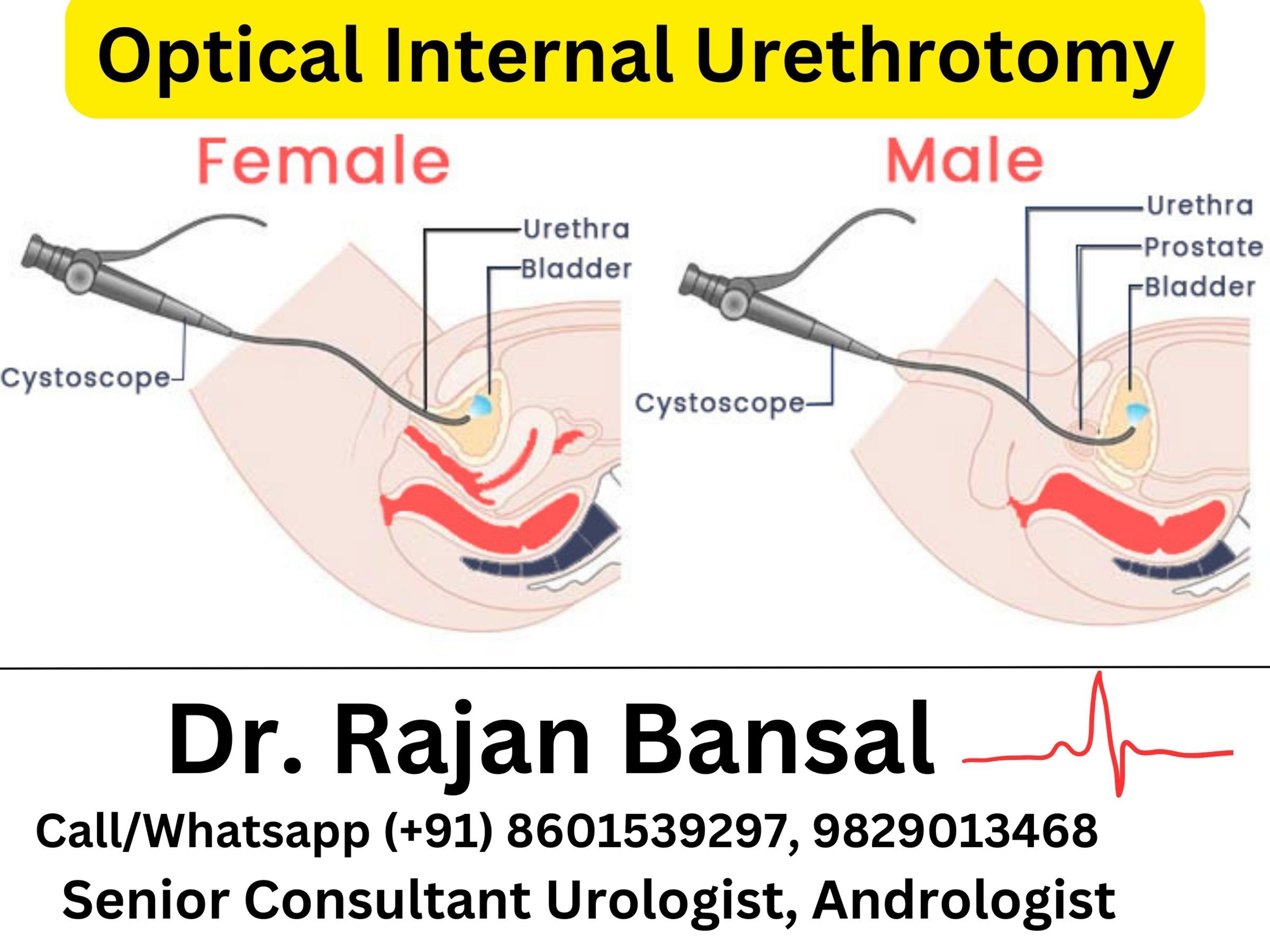Urethral Stricture: Causes, Symptoms, Diagnosis, and Treatment: Urethral stricture is a medical condition that affects the urethra, the tube that carries urine from the bladder to the outside of the body. A stricture is a narrowing of the urethra. This condition can cause difficulty urinating, pain during urination, and other uncomfortable symptoms. Stricture can affect any part of urethra but Bulbar (middle part of urethra) urethral stricture is the most common type. In this article, we will explore the causes, symptoms, diagnosis, and treatment options for bulbar urethral stricture.

Causes of Bulbar Urethral Stricture:
The exact cause of bulbar urethral stricture is not known, but there are several factors that may contribute to its development. Some of the most common causes of bulbar urethral stricture include:
Infection: Infections of the urinary tract or sexually transmitted infections can lead to inflammation and scarring of the urethra, which can cause a stricture.
Catheterization: Repeated or prolonged use of a urinary catheter can cause irritation and damage to the urethra, leading to the formation of a stricture. This is the most common cause of bulbar urethral stricture.
Surgery: Certain surgical procedures, such as prostate surgery or urethral reconstruction surgery, can increase the risk of developing a stricture.
Trauma: Trauma to the pelvic area, such as from a car accident or sports injury, can cause damage to the urethra, leading to the formation of a stricture. Repeated trauma due to brachytherapy treatment has also been linked to bulbar urethral strictures.
Symptoms of Bulbar Urethral Stricture:
The symptoms of bulbar urethral stricture can vary depending on the severity of the stricture. Some of the most common symptoms include:
- Difficulty starting urination or a weak urine stream
- Dribbling of urine after urination
- Interrupted or Weak stream of Urine
- Pain or discomfort during urination
- Frequent urination or the urge to urinate more often
- Inability to completely empty the bladder
- Blood in Urine
Diagnosis of Bulbar Urethral Stricture:
To diagnose bulbar urethral stricture, your doctor will likely perform a physical examination and take a detailed medical history. They may also perform some of the following tests:
Urine Tests: A urine sample may be taken to check for signs of infection or other abnormalities.
Uroflowmetry: This test measures the speed and volume of urine flow.
Retrograde Urethrography: During a retrograde urethrography procedure, a thin, flexible tube called a catheter is inserted into the urethra. Contrast dye is then injected through the catheter to fill the urethra, and X-ray images are taken as the dye flows through the urethra. The contrast dye helps to highlight the structure of the urethra on the X-ray images, allowing the doctor to identify any narrowing, strictures, or other abnormalities.
Cystoscopy: A thin, flexible tube with a camera on the end (cystoscope) is inserted into the urethra to examine the inside of the bladder and urethra.
Treatment Options for Bulbar Urethral Stricture:
Treatment options for bulbar urethral stricture depend on the severity of the stricture, the location and length of the stricture, the patient’s overall health, and other factors. The following is a detailed overview of treatment modalities for bulbar urethral stricture:
Dilation:
Dilation is a procedure that involves gradually increasing the diameter of the urethra using a series of progressively larger dilators. The dilators may be metallic, plastic or rubber, and may be rigid or flexible. The procedure is done under local anesthesia and can be performed on an outpatient basis. The procedure may need to be repeated periodically as per the patient response.
Urethrotomy:
Urethrotomy is a minimally invasive procedure that involves making a small incision in the stricture using a blade or laser. This procedure is done under regional or general anesthesia. It is important to note that stricture invariably reoccurs and patients mostly need urethral dilatation under local anaesthesia periodically.
A. Visual Internal Urethrotomy (VIU): Visual Internal Urethrotomy (VIU) is a minimally invasive procedure that involves the use of an endoscope to visualize the urethra and cut the stricture using a blade. This procedure is done under regional or general anesthesia.
B. Laser urethrotomy: Laser urethrotomy is a minimally invasive procedure that uses laser energy to cut through the stricture. This procedure is done under regional or general anesthesia. The success rate of laser urethrotomy is similar to that of urethrotomy using a endoscopic knife or blade (VIU) but added advantage of having less bleeding and pain after the procedure. Both procedures involve one day of hospitalisation.
Urethroplasty:
Urethroplasty is a surgical procedure that involves removing the affected portion of the urethra and reconstructing it using healthy tissue. This procedure is performed under general or regional anesthesia and may require a hospital stay of 5 to 7 days. The success rate of urethroplasty is high, with success rates ranging from 80% to 90%. Urethroplasty is considered the gold standard treatment for bulbar urethral stricture, especially for the reoccurring ones. Post-surgery periodic dilatation is usually not required after Urethroplasty procedure.
Buccal mucosal graft Urethroplasty:
Buccal mucosal graft is a surgical procedure that involves taking a graft of tissue from the inside lining of the cheek (buccal mucosa) and using it to reconstruct the urethra. This procedure is performed under general anesthesia and may require a hospital stay of 5 to 7 days. The success rate of buccal mucosal graft is high, with success rates ranging from 70% to 90%.
Prevention of Bulbar Urethral Stricture:
While it may not be possible to prevent all cases of bulbar urethral stricture, there are some things you can do to reduce your risk of developing this condition. Some preventative measures include:
Practice safe sex: Use condoms to reduce your risk of contracting sexually transmitted infections.
Avoid unnecessary catheterization: Try to avoid prolonged or repeated use of urinary catheters if possible.
Seek prompt treatment for infections: If you have a urinary tract infection or other infection in the genital area, seek prompt treatment to reduce the risk of scarring and inflammation.
Follow up with your doctor: If you have a history of urethral stricture or other urinary tract issues, it’s important to follow up with your doctor for regular checkups and screenings.
Best Hospital for Urethral Stricture Treatment (Both Laser Surgery & Urethroplasty) – Institute of Urology, C Scheme, Jaipur
Bulbar urethral stricture can cause discomfort and urinary difficulties, but there are effective treatment options available. If you experience any symptoms of bulbar urethral stricture, it’s important to see a good urologist for a diagnosis and treatment plan. At Institute of Urology, we are dedicated to patient care to the best of our abilities. We maintain complete discreetness throughout your journey with us.
You can reach me directly via call or whatsapp on 8601539297 (Dr. Rajan Bansal) or you can also come and see me at the hospital, all days a week during working hours. You can also book an appointment at 9829013468 which would help me attend to you on a priority basis.







